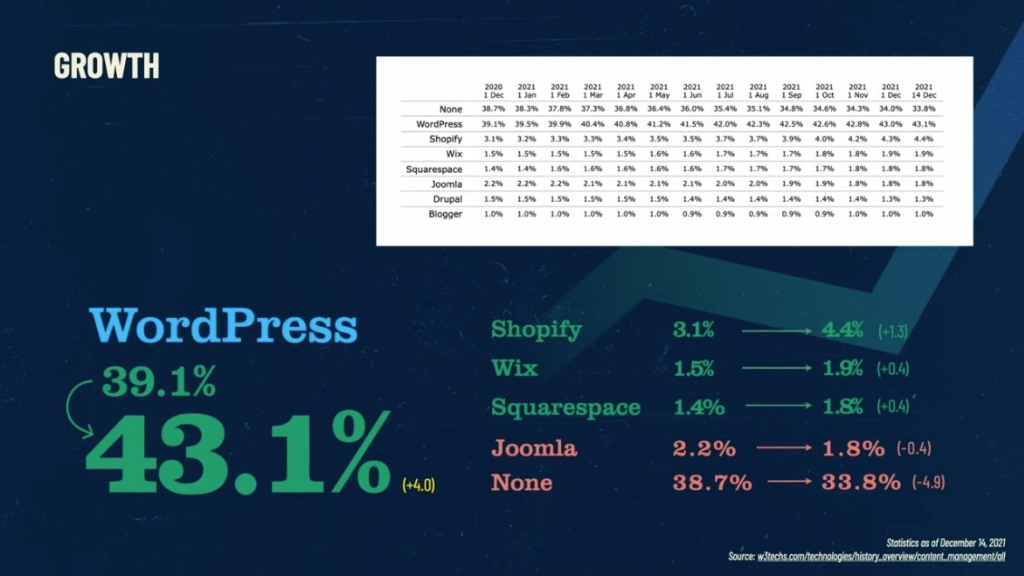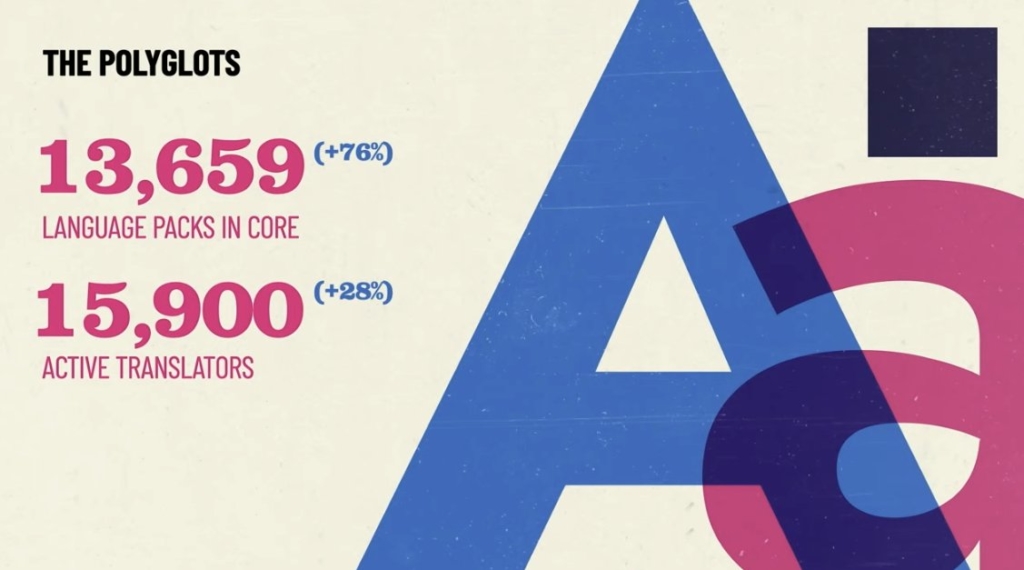It’s essential viewing for anyone involved or interested in WordPress development, however, if you haven’t had a chance to catch the 2021 event, which was live-streamed from New York on 14 December, here we cover some of the key takeaways.
Growth
2021 saw tremendous growth for WordPress, which now powers 43.1% of websites according to W3Techs – this is an increase of 4% from the previous year, as we’re seeing more content creators move across from non-discernable, custom publishing systems to market-leading solutions. WordPress is notably the only open source CMS experiencing growth, and it aims to maintain this by staying humble, staying close to its users, and iterating its software as quickly as possible. The last year has also seen double the amount of themes added to the WordPress directory compared to 2020, and impressively, a 11.63% increase in brand new downloads of its software – excluding updates – resulting in the highest number of new downloads in a single year in the platform’s history!

Openverse
The tool formerly known as Creative Commons Search was this year moved across to WordPress.org to ensure its longevity, and now provides easy access to around 600million openly licensed images. By the end of January 2022, Openverse is expected to also feature 2million openly licensed audio clips, creating as much open content on the web as possible and furthering the WordPress mission to democratise publishing.
Patterns
The newly created Pattern Directory makes it much simpler to add unique layouts to a WordPress site, creating a huge opportunity for designers to contribute to the WordPress ecosystem without coding knowledge. While the first version of Gutenberg provided fundamental building blocks for creators – like Lego bricks or strands of DNA – Patterns enable anyone with either no-code or low-code experience to be able to create and share complex presentations of what can be achieved using blocks.
Polyglots
2021 has seen a 76% improvement in the language packs that are being created for plugins in core – which have increased to 13,659 – as well as a 28% improvement in active translators which now stand at around 15,900. As a result, WordPress is now translated to 71 locales, democratising publishing beyond English-speaking countries.

Diversity
The Diverse Speaker Training Group has expanded to three programs – Diverse Speaker Program, Allyship Program, and Diverse Speaker Support Program – which aim to empower people across the world to speak at WordCamp or WordPress events. So far, 135 participants have taken part – spread across 66 cities and 16 countries – and there’s a commitment to significantly boost these numbers in the near future.
Learning
In the previous State of the Word address, Matt talked a lot about learn.wordpress.org and how we can teach more people about the power of WordPress – since then there have been 186 learning spaces, 73 workshops, and 70 lesson plans created that teachers and lecturers can share with their students in 21 languages. There are also now two courses that are full collections of lessons and plans, and while only around 1,000 people have taken the courses so far, it’s anticipated that this number will grow significantly as the content continues to improve through iterations.
Security
A solid year for WordPress security, with 30 people contributing to WordPress security patches (a third of those were first-time contributors), and in the WordPress security reporting system, 71% of reports were closed as not applicable, and 5.6% were duplicates. Matt emphasised that security is a process and not an endpoint, and that the key for WordPress to become the world’s most secure system is to focus on how it’s updated.
Block themes
While this time last year there were only two block themes – which are built from the ground up to be fully customisable within the Gutenberg editor – that’s now increased to 28, and the total is expected to soar much higher in the coming months. The new default block theme – Twenty Twenty Two – will launch with the 5.9 release (postponed until January) and makes full use of blocks, theme.json and a plethora of design tools.
5.8 features
Following the WordPress 5.8 update, it’s now also possible to manage widgets with blocks, and the query block was launched too so you can now display your posts and pages with blocks. The advanced block also comes built-in with various layouts that you can easily switch between.
5.8 also marked the launch of Duotone, an image filter that enables you to entirely replace the colours of your images with two shades of your choice – one for shadow and one for highlights – enabling you to create a visual consistency across images without the use of external imaging software.
Contributors
Matt emphasised that all of the above was made possible by the thousands of people that contribute to WordPress, including an additional eight people who became new core committers in 2021. 481 people contributed to the 5.7 Esperanza release (24% new contributors), 530 contributed to the 5.8 Tatum update (25% new contributors), and so far, around 580 people have worked on the upcoming 5.9 update. He also strongly encouraged members of the wider WordPress community to contribute in whatever way they can, with a focus on the Five for the future initiative.
5.9 update
While Matt joked that it’s possible that 2022 could be the year of four releases, what’s certain is that it will begin with the 5.9 update which has been postponed until January. This will include Duotone support for featured images and theme.json integration, improved Gallery with drag and drop, List View drag and drop, integrated Pattern Directory, border block support, and block spacing with a single control – you can watch a concise overview of it here.

Moving on to a wider view of the market, Matt also talked about Web3 and the two core ideas it embodies – decentralisation and individual ownership – and how those are central to WordPress and its commitment to demotracitising publishing. He also gave a refresher on the four rollout phases for Gutenberg, emphasised the importance of continued contribution from across the community, and proudly announced that after a lengthy hiatus due to the COVID-19 pandemic, #WCUS will be held in San Diego, California in September 2022. You can watch the highlights of the address here.


